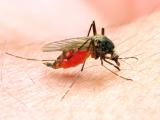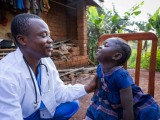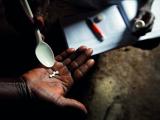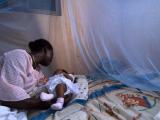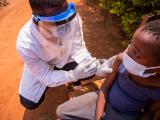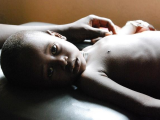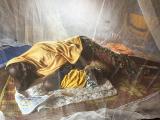Oct 18, 2011 (CIDRAP News) – In a closely watched trial of the world's first malaria vaccine in thousands of African children, researchers today reported that in the latest phase of testing, the vaccine prevented about half of malaria infections in young children.
The study, published early online by the New England Journal of Medicine, is part of a phase 3 trial involving 15,000 children at 11 centers in 7 African countries. Experts have projected that the vaccine could be on the market as early as 2015, according to previous reports.
The Roll Back Malaria Partnership, a global public-private partnership of more than 500 organizations, has estimated that malaria leads to 781,000 deaths a year. Because 40% of the world's population is at risk for malaria, the disease hinders social and economic development in the world's poorest communities.
The RTS, S malaria candidate vaccine contains an AS01 adjuvant and is given in three doses. The study was sponsored by the vaccine's maker, GlaxoSmithKline, and funded by GSK and the Program for Appropriate Technology in Health (PATH) Malaria Vaccine Initiative through a grant from the Bill and Melinda Gates Foundation.
The randomized controlled trial uses efficacy against clinically confirmed malaria as the end point, a type of study considered the gold standard for measuring vaccine efficacy.
The vaccine first entered clinical trials in 1992, and in phase 2 trials over the past few years showed promise in children ages 8 to 16 weeks and 5 to 17 months.
Today's report describes results from the first stage of the phase 3 trial, which mainly assessed vaccine efficacy in the first 6,000 children ages 5 months to 17 months who received the vaccine and compared them with those who received a rabies vaccine used as a control. It also assessed vaccine efficacy in younger infants, ages 6 to 12 weeks. The control vaccine used in the younger group was a meningococcal vaccine. The trial also assessed the vaccine's safety and immunogenicity.
Children received three doses of the vaccine at 1-month intervals.
During the year following the last dose, parents or guardians were asked to report adverse events that occurred within 30 days of vaccination. They were also asked to seek care for children who became sick with any type of illness at a study facility, allowing researchers to monitor incidence of malaria and the severe form of the disease.
To assess immunogenicity, researchers measured anti-circumsporozoite antibody titers in the first 200 children at each study center at enrollment and 1 month after the third dose of the malaria vaccine was given.
After 12 months of follow-up in the older age-group, vaccine efficacy against all clinical malaria episodes was 55.1% (95% confidence interval [CI], 50.5 to 59.3). Against severe malaria, vaccine efficacy was 47.3% (95% CI, 22.4 to 64.2). In the pooled age category that included the younger infants, vaccine efficacy against severe malaria was 34.8% (95% CI, 22.4 to 64.2).
Reports of adverse events occurring within 30 days of vaccination were similar in both study groups. The most frequently reported symptoms were pain and fever.
The investigators found low titers of anti-circumsporozoite antibodies in both groups at baseline, but 1 month after the third dose of vaccine, 99.9% of children in the malaria vaccine group were positive for the antibodies.
The efficacy findings were generally consistent with phase 2 studies, though the authors found that the level of protection was lower 12 month after children received the third dose of vaccine, a pattern not seen in phase 2 trials. The group noted that waning immunity, acquisition of natural immunity, and differences in exposure are factors that might explain the decrease, and that further follow-up and evaluation of a booster dose will help tease out the contribution of the factors.
They also noted that the vaccine efficacy against severe malaria was lower in the pooled age-group than it was in the older age-group and wrote that phase 2 findings suggested similar efficacy between the two groups. They said continued follow-up will shed more light on efficacy in younger children against both types of malaria, along with duration of efficacy.
Mortality from malaria was very low in the trial, with the disease responsible for only 10 (6.6%) of 161 reported deaths, which the authors attributed to good access to high-quality medical care at the study centers.
More systemic and local side effects were seen in kids who received the malaria vaccine, though few were severe, according to the report. The incidence of seizures in the 7 days after vaccination was higher than that recorded for the rabies vaccine, though all were associated with fever and all the children recovered. An increase in the rate of meningitis illness was detected in children who received the malaria vaccine, and the researchers said that additional data from ongoing studies will clarify the relationship, though they said the events likely aren't related.
In other phases of the ongoing study, researchers said they expect to present findings in the first 6,000 young infants (ages 6 to 12 weeks) in about a year. Data on the duration of the vaccine's protection is expected in 2014.
Tom Frieden, MD, MPH, director of the US Centers for Disease Control and Prevention (CDC), said in a statement today that the study results are a promising advance in the development of a malaria vaccine for African children. He said the CDC, along with partners at the Kenya Medical Research Institute, led the trial at one site in western Kenya.
He said data from the next two phases of the study will be "critical to understand how the vaccine may be used to control malaria."
Frieden pointed out that the vaccine provided protection in settings where effective malaria interventions such as bed nets, antimalarial drugs, and indoor residual insecticide spraying are in use.
"Thanks to sharp increases in global funding for malaria during the past decade, many African countries have been able to scale up the distribution and use of these safe, effective, and affordable life-saving interventions," he said "As a result, many countries have seen decreases of up to 50 percent in deaths of children younger than 5 years."
The vaccine trial adds hope that adding an effective vaccine to other malaria-fighting efforts can move the Roll Back Malaria Partnership closer to its goal of achieving near zero preventable malaria deaths, Frieden said.
A new report released by the Roll Back Malaria Partnership said that over the last decade the rapid scale-up of a host of malaria control measures has saved an estimated 1.1 million lives in Africa alone and cut the death toll by 38%, according to a press release.
It said the momentum is encouraging more countries to consider the next steps toward malaria elimination. Seven countries have recently eliminated the disease, the group said. Of 108 countries where malaria remains endemic, 10 are monitoring transmission to arrive at zero cases, and 9 more are preparing to move toward malaria elimination.
The RTS, S Clinical Trials Partnership. First results of phase 3 trial of RTS, S/AS01 malaria vaccine in African children. N Engl J Med 2011 Oct 18 [Full text]
See also:
Oct 18 CDC statement
Oct 17 Roll Back Malaria press release
